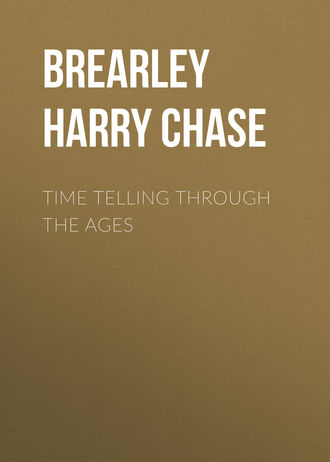 полная версия
полная версияTime Telling through the Ages
Ulm– In the eastern end of the old Rathaus at Ulm is installed an astronomical clock which dates from the beginning of the 16th century. It was thoroughly repaired in 1549 by the builder of the Strasburg clock – Isak Habrecht. Shows in addition to the hours, the diurnal and annual revolutions of the earth and the movements and phases of the moon. The clock is an artistic achievement as well as a mechanical wonder.
Vailly's– A scientific water clock. It consisted of a tin cylinder divided into several small cells and suspended by a thread fixed to its axis, in a frame on which the hour distances fixed by trial were marked. It was so made that the water passed slowly from one cell to the next and as it did so it changed the center of gravity of the cylinder and set it in motion so as to indicate the time on the frame. Made about 1690.
Wallingford's– Built in 1326 in St. Alban's Monastery. It showed besides the hours, the apparent motion of the sun, the ebb and flow of tides, changes of moon, etc. It continued to run until the time of Henry VIII. Held by some to have been a mere planetarium.
Wells Cathedral– Clock built by Peter Lightfoot, A. D. 1340 at Glastonbury and removed to Wells Cathedral during the Reformation, after the dissolution of the Glastonbury monastery. In 1835 it was again removed to the South Kensington museum. At that time the worn-out works were replaced by a new train, but the dial and knights were retained. The dial is divided into twenty-four hours and shows the motion of the sun and moon. On its summit are eight armed knights tilting at one another, lance at rest by a double rotary motion.
Westminster– A clock said to have been erected at Westminster with the proceeds of a fine imposed upon one of the Chief Justices about 1288. About 1365 Edward III had a stone clock tower erected at Westminster. This tower contained a clock which struck the hours on a great bell. It also contained other bells. This tower was razed by the Roundhead mob about 1650. Later a dial with the motto "Discite justiam monite" was placed on the site. The bell "Great Tom" was given to St. Paul's about the beginning of the 18th Century. The present Westminster clock is made after plans by E. B. Denison (Sir Edmund Beckett) and made by E. J. Dent. The bell is called "Big Ben." It is claimed to be the best timekeeper of its kind in the world. It was for use in this clock that Denison invented his gravity escapement.
Wimborne– A very old clock at Wimborne in Dorsetshire, much like the Wells Cathedral clock. By some authorities believed also to have been planned by Peter Lightfoot.
Clock-Setters – During the early history of turret clocks, for each one was employed a caretaker called the "setter." That such an official was needed indicates that they were more or less undependable.
Cock – A horizontal bracket. See: Balance Cock; Escape Cock; Pendulum Cock; Potance.
Collet – A collar or flange on a cylindrical piece of metal. Any part of such cylinder of greater diameter than the rest. Sometimes of the same piece of metal; sometimes fitted friction tight upon it.
Compensation – The provision made in a clock or watch to counteract the expansion and contraction due to variations of temperature. In the clock it is applied to the pendulum; in the watch to the balance.
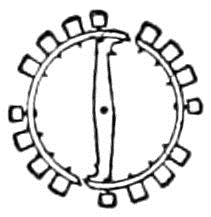
Compensation Balance – A balance corrected for errors caused by variations in temperature. The type in most general use was invented by Thomas Earnshaw in the second half of the 18th century. The double rim of this balance is constructed of brass and steel soldered together in the form of a cut ring, the brass on the outside. When heat, elongating the balance ring, causes it to vibrate more slowly, the brass, expanding more than the steel, bends the free ends of the cut rim toward the center, thus decreasing the diameter of the balance and quickening the vibration. On the other hand, when cold, contracting the ring tends to quicken the vibration of the balance, the contraction of the brass rim draws the free end outward, making the diameter larger and the vibration slower in consequence. The compensation balance is also made with brass as the inner metal and aluminum outside.
Compensation Curb – A laminated bar of brass and steel or aluminum and brass fixed at one end, the free end carrying the curb pins that regulate the length of the balance spring. Common in old watches but not now in use.
Compensation Pendulum – A pendulum so constructed that the distance between the point of suspension and the center of oscillation remains constant in all temperatures. See: Pendulum, Gridiron and Pendulum, Mercurial Compensation.
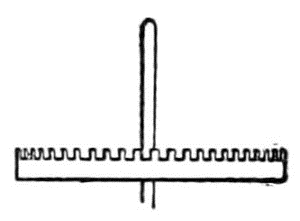
Contrate Wheel – A wheel whose cogs are parallel to its axis and whose axis is at right angles to the axis of the wheel into which it gears. A crown wheel.
Corrosion – The eating or wearing away of metals by slow degrees through chemical action.
Countersink – To enlarge the outer end of a hole for the reception of the head of a screw, bolt, etc. The term is also applied to the tool with which the countersink is formed.
Coventry – A municipal, county, and parliamentary borough of Warwickshire, England. One of the important watchmaking centers of Great Britain.
Crown Wheel – A wheel whose teeth project at right angles to the plane of the wheel. A contrate wheel. The escape wheel of the verge escapement is an illustration.
Crutch – A light rod in a clock descending from the pallet arbor and ending in a fork which embraces the pendulum rod. It transmits the motion of the pallet to the pendulum.
Ctesibus – A famous Greek mechanician who lived in Alexandria about 130 B. C. Although his was not the first clepsydra as is claimed by some it was an ingenious and interesting one. Believed to have first applied toothed wheels to clepsydrae about 140 B. C.
Curb Pins – See Banking Pins.
Cusin, Charles – A watchmaker from Autun, Burgundy, who laid the foundation for the Swiss watch industry in Geneva in 1587. It grew very slowly at first – in 1687 having only one hundred watchmakers with three hundred assistants. In 1760 there were at Geneva eight hundred watchmakers with 5,000 to 6,000 assistants.
Custer, Jacob D. – (1809-1879.) A Pennsylvania clockmaker in 1831; he was one of the early makers of watches in America in 1840. However, his work was not important commercially, for he produced only about a dozen watches. A very ingenious man, who, it is said, made everything from a steam engine to his own shoes. He made hundreds of the clock movements which at that period were used to revolve the lanterns in lighthouses.
Cycle of the Sun – A period of twenty-eight years, after which the days of the week again fall on the same days of the month as during the first year of the former cycle. It has no relation to the sun's course but was invented for the purpose of finding out the days of the month on which the Sundays fall during each year of the cycle. Cycles of the sun date from nine years before the Christian era.
Cycloid – A curve generated by a given point in the circumference of a circle which is rolled along a straight line always in the same place. Example: The curve traced by any point in the rim of a wheel which travels in a straight line along a level road.
Cylinder Escapement – See: Escapement, Cylinder.
Cylinder Plugs – Plugs fitted into the ends of the cylinder of a cylinder escapement. Their outer extremities are formed into the pivots on which the cylinder rotates.
Damaskeen – To decorate a metal by inlaying other metals or jewels, or by etching designs upon its surface. To be distinguished from snailing, with which it is often confounded.
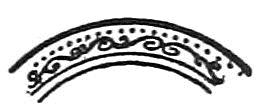
Day – The time of one complete revolution of the earth on its axis. The actual length of this day is continually changing owing to the eccentricity of the earth's orbit and the angle of the ecliptic. The mean solar day is 24 hours. The sidereal day is 23 hours, 56 minutes, 4.099 seconds.
Day, Nautical – The nautical day begins when the sun is on the meridian and eight bells are struck. The day is divided into "afternoon watch" or four hours, two "dog watches" of two hours each, then "middle watch," "night watch," "morning watch" and "forenoon watch," each of four hours, completing the day.
Denison, Edmund Beckett – Sir Edmund Beckett – Lord Grimthorpe. Born 1816. A lawyer by profession, and the inventor of the gravity escapement for turret clocks; also an authoritative writer on horological subjects. He designed and planned the Westminster clock said to be the best timekeeper of its kind in the world. Died 1905.
Dennison, Aaron L. – Born in Freeport, Me., in 1812. Died Birmingham, England, January 9, 1898. At eighteen he was apprenticed to a watchmaker. Later in working at the trade, he was impressed with the inaccuracies which existed in the best handmade watches. This, with a visit to the Springfield Armory, gave him his idea of machine-made watches with interchangeable parts. He interested Edward Howard in the project, and having found the needed capital they started in the business and laid the foundation of what is now the Waltham Watch Company. Dennison has been called the "father of American Watchmaking" tho there seems ground for the claim that he shares that honor with Edward Howard.
Depthing – The technical name for the proper adjusting or spacing of the gearing in a watch.
Detent – The device which halts, and releases, at the proper instant the escapement of a clock or chronometer. See: Escapement.
de Vick, de Wyck, or de Wieck, Henry – A German clockmaker who, in 1364, made the first turret clock of which reliable information and description remains. The clock was made for Charles V. See: Clocks, Interesting Old – De Vick's.
Dial – Commonly called the face of the watch – made of gold or silver or other metal or of enamel, with the required figures – in the United States one to twelve upon it in a contrasting color. See also, Sun-dial.
Dial Feet – Short wires soldered to the back of the dial of a watch or clock which hold it in place by fitting into holes in the pillar plate.
Dial of Ahaz – A sun-dial belonging to Ahaz, King of Judea 742-727 B. C., mention of which occurs twice in the Scriptures – II Kings, XX: 9-11, and Isaiah XXXVIII: 8. It is believed that one of his Babylonian astrologers constructed it for him.
Dial Plate – See Lower Plate.
Dial, Sun – See Sun-dial.
Dial Wheels – The wheels constituting the motion work of a watch.
Diurnal – In an astronomical sense, pertaining to a period covering a mean solar day. See: Solar Time.
Dog Screw – A screw with an eccentric head used to attach a watch movement to a dome case.
Dog-Watch – A nautical term for two daily two-hour periods of watching aboard ship. The first begins at 4 P. M., the other at 6 P. M.
Dolmen – A sacred instrument used for astronomical purposes at certain critical periods of the year; formed of four stones at the cardinal points and a leaning stone crossing diagonally and forming with the east stone a sacred "creep-way." The solar hours were indicated by the shadow of the leaning stone touching various prominent points or edges. One at Camp, England, is prehistoric.
Dome – The inner case of a watch which snaps on the band of a case.
Dome-Case – A case in which the inner case or dome snaps to the band of the case.
Dondi, Giacomo – Born at Padua, Italy, in 1298. In 1344 he set up at Padua a famous clock which became a model for later clocks and which earned for him the surname, "Orologio."
Double Bottom Case – A watch case in which the inner cover or bottom is made solid with the middle. The vogue in English cases for a long time; now almost obsolete.
Double-Sunk Dial – A dial in which there are two sinks; one for the hour hand, and a deeper one for the seconds hand.
Draw – 1. The force which holds the lever against its bank, due chiefly to the angle of the locking face of the pallet stone. 2. The angle of the locking faces of pallets in the lever escapement.
Driver – Of two wheels working together, the one which imparts the power. The driven wheel is termed the follower.
Driving Wheel – In a clock the wheel on the main arbor which drives the whole train.
Drop – That part of the motion of the escape wheel when it is not in contact with the pallet.
Drum – The cylinder, or barrel, on the main arbor in a clock on which the driving cord winds, raising the weight, when the clock is being wound.
Dummy Watch – (Fausse Montre.) About 1770 it became the fashion to wear two watches. But because two real watches were too expensive for most people, the custom grew up for having one sham watch – usually worn on the right side. These were called "dummy watches" or "fausse montres."
Earnshaw, Thomas – 1749-1829. An eminent English watchmaker who invented the spring detent escapement and the compensation balance, both essentially the same as are now used in chronometers. He first soldered brass and steel together for the balance instead of riveting them.
East, Edward – Watchmaker to Charles I and an eminent horologist. He was one of the ten original assistants named in the charter of the Clockmakers' Company and at once took a leading part in their proceedings. He was elected master in 1664 and 1682. He was the only treasurer ever appointed by that company. He died probably about 1693. East's watches were often presented as prizes by Charles in tennis tournaments.
Edward VI – King of England from 1546 to 1553. Said to have been the first Englishman to wear a watch.
Electric Clock – A clock in which the pallets moved electrically from a distant mechanism drive the escape wheel and the hands.
Ecliptic – That plane passing through the center of the sun in which lies the orbit of the earth. Also used to designate the apparent path of the sun in the heavens.
Elgin – A city in Illinois, U. S. A., in which is located the Elgin National Watch Company – one of the largest factories in the United States.
End-Shake – Freedom of pivots to move endways. Necessary in a watch or clock because there is no force to spare and a tight pivot would stop the movement.
End-Stone – A small disc of jewel against which the end of a pivot sets. See Capped Jewel.
End-Stop – In a watch the same as end-stone.
Engaging Friction – Friction which results when the teeth of two wheels gearing together come into action before reaching the line of centers – that is, a line drawn from center to center of the gearing wheels.
Engine-Turning – A pattern of curved lines cut into metal for decoration. Introduced about 1770 by Francis Guerint of Geneva. The earliest specimens were cut very deep but shallower cutting soon became the rule.
Engraving – A form of ornamenting metals in which the design is cut into the metal. In "Champ-leve" engraving the ground is cut away leaving the design in relief.
Epact – The excess in time of the solar year over the period of 12 lunar months, amounting to about 11 days. The new moons will thus fall about 11 days earlier in each succeeding year. In a calendar so arranged 30 days are taken off every fourth year, as an intercalary month, the moon having revolved once in that time, and the three days remaining would be the epact. The epact thus continues to vary until at the end of nineteen years the new moons return as at first.
Epicycloid – A curve generated by any point in the circumference of a circle as it rolls on the outside of the circumference of a fixed circle. This curve is the best for the face of the teeth of a driving wheel.
Equation Clocks – An obsolete form of clock which showed true solar or sun-dial time instead of mean solar, or average time.
Equation of Time – The difference between true time and mean, or averaged time. There are four days in the Gregorian year when the true time and mean time agree, and the equation of time is zero: These are December 24, April 15, June 15, and August 31. Between the first two dates and the last two dates, true time is earlier than mean time; for the other two periods of the year it is later.
Escape Cock – The bracket which supports the upper ends of the escape wheel and pallet staff arbors.
Escapement – The device in a watch or clock which regulates the motion of the train thus distributing the power of the main-spring. It communicates the motive power to the balance or pendulum. Escapements are of three classes: recoil, dead, or dead-beat; and detached.

Escapement, Anchor – The recoil escapement, invented by Hooke, used in most house clocks. A name also applied to one kind of Lever Escapement with an unusually wide impulse pin. The recoil escapement is one in which each tooth of the escape wheel, after it comes to rest, is moved backward by the pallets. Altho one of the easiest escapements to set out correctly the pallets are often improperly formed making an escapement which gives indifferent service. As a timekeeper the anchor escapement is inferior to the dead-beat escapement.
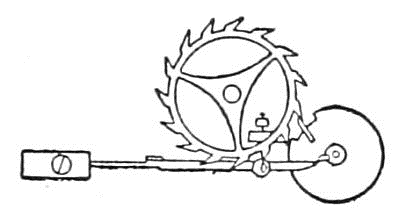
Escapement, Chronometer – A detached escapement in which the escape wheel is locked on a stone carried in a detent, and in which the teeth of the escape wheel impart an impulse to a pallet on the balance staff with every alternate vibration. Used in Marine Chronometers.
Escapement, Crown-Wheel – Of the recoil type, and the earliest known escapement; to be found in Henry de Wyck's clock. Not suitable for watches. Practically the same principle as Verge or Vertical Escapement used in watches for so many years.
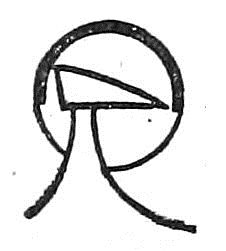
Escapement, Cylinder or Horizontal – Invented by Thomas Tompion in 1695 – later improved and brought into general use by Graham. It dispensed with the then common vertical crown-wheel – hence the term "horizontal" and permitted thinner watches. This escapement is frictional, the balance being carried on a hollow cylinder whose bore is large enough to admit the teeth of the escape wheel. The cylinder is cut away where the teeth enter and the impulse is given by the wedge shaped teeth striking against the edge of the cylinder as they enter and leave. Used at this time in the cheaper Swiss watches.
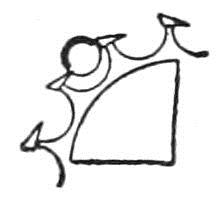
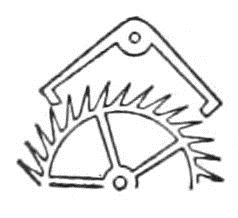
Escapement, Dead-Beat – Any escapement in which the pallet face is so formed that the escape wheel remains dead or motionless during the supplementary arc of the balance or swing of the pendulum. As invented by George Graham, the wheel is much the same as the wheel in the anchor escapement, the difference lying in the shape of the pallets. Each pallet has a driving face and a sliding face. It is so arranged that the impulse is given the pendulum at the midpoint of its swing thus allowing the swing to adapt itself to the impulse and keep the time constant. The pallets are faced with jewels so that there is slight friction. Used in high grade clocks such as regulators and astronomical clocks.
Escapement, Detached – Any escapement in which the balance or pendulum is for some time during each vibration free from the pressure of the train. Detached escapements are used in chronometers, most watches and in turret clocks. They are of value in any movement where the motive power varies greatly – hence in turret clocks. Examples: Chronometer, lever, and gravity escapements.
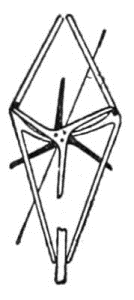
Escapement, Double Three-Legged Gravity – Invented in 1854 by E. B. Denison, Esq., for the great clock at the Houses of Parliament. It is the best escapement for very large clocks where the hands are exposed to the action of the wind and snow, because it admits of great driving power in the movement without its sensibly affecting the escapement as would be the case in the dead-beat type. The impulse to the pendulum is given by the weight of the lever arms falling through a given distance and is therefore constant. This escapement consists of two gravity impulse pallets pivoted in a line with the bending point of the pendulum. There is a locking wheel made of two thin plates of three teeth each. Between these plates are the three pins that lift the pallets. The locking is effected by blocks screwed to the front of one pallet and the back of the other. Impulse is given by the pallets in turn striking the pendulum rod. The pendulum rod serves to unlock the wheel. The arrangement is such that the lifting pins have a little free run each time. Since the pallets are always lifted the same distance they give a constant impulse to the pendulum.
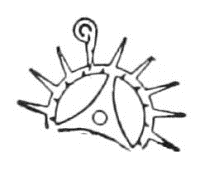
Escapement, Duplex – Invented by Hook; later improved by Tyrer. Very accurate but as originally made was affected by any sudden motion, and hence of little use in watches. The escape wheel has two sets of teeth. Those farthest from the center lock the wheel by pressing on a hollow ruby cylinder fitted round the balance staff and notched so as to permit the passing of the teeth as the balance moves in a direction opposite to the wheel's motion. The second set stand up from the face of the wheel and one gives impulse to the pallet every time a tooth leaves the notch. This is not a detached escapement, but there is little friction. As improved this escapement was used in the famous Waterbury watches.
Escapement, Foliot – A form of escapement actuated by a foliot balance. See Foliot.
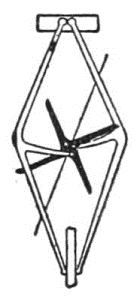
Escapement, Four-Legged Gravity – Invented by E. B. Denison (Sir Edmund Beckett). The same in principle as the Double Three-Legged escapement, only it has but one escape wheel with four teeth or legs instead of two wheels with three legs each. The wheel has two sets of lifting pins – one acting on each pallet. Occasionally used in regulators and other clocks with a seconds pendulum, but of doubtful, if any, advantage over the Graham dead-beat escapement.
Escapement, Frictional – Any escapement in which the balance is never free from the escapement. Examples: The Cylinder, Duplex and Verge types.
Escapement, Gravity – An escapement which gives impulse to the pendulum by means of a weight falling through a constant distance. Of use in turret and other exposed clocks where the hands' movements are affected by wind, rain, and snow. See subtitles under these headings: Double Three-legged Gravity; Single Three-legged Gravity; Four-legged Gravity; Six-legged Gravity.
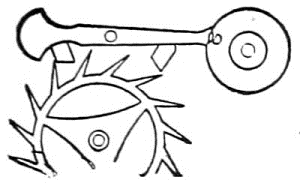
Escapement Lever – Invented by Thomas Mudge about 1765. It is the preferred escapement for watches because of the certainty of its performance. Possibly inferior to the chronometer escapement as a timekeeper. Its most noticeable defect is the necessity of applying oil to the pallets, the thickening of which affects the action. There are many other kinds of lever escapements. The Mudge escapement was essentially like the modern Double Roller. The connection between the balance and the escape wheel is made by a lever to which the pallets are fastened, and into the forked end of which plays the ruby pin which is carried on a roller on the same staff as the balance. Each pallet has an impulse face and a locking face. The impulse is given by the escape wheel tooth striking the impulse face of a pallet and is communicated to the balance by the lever, raised by the pallet's movement striking the ruby pin in the roller. This ruby pin also serves to unlock the pallets by causing the lever to lift them in turn. This escapement is of the detached type. The action of the lever is kept within the desired limits by banking pins.

